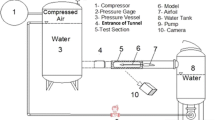Abstract
The most complicated component in cavitating flow and pressure distribution is the flow in the cavity closure line. The cavitating flow and pressure distribution provide critical aspects of flow field details in the region. The integral of pressure results of the hydrodynamic forces, indicate domination in the design of a supercavitating vehicle. An experiment was performed in a water tunnel to investigate the pressure characteristics of the cavity closure region. Ventilation methods were employed to generate artificial cavity, and the ventilation rate was adjusted accordingly to obtain the desired cavity length. An array of pressure transducers was laid down the cavity closure line to capture pressure distribution in this region. The experimental results show that there is a pressure peak in the cavity closure region, and the rise rate of pressure in space tends to be higher in the upwind side when the flow is non-axisymmetric. The transient pressure variations during the cavity formation procedure were also present. The method of measurement in this paper can be referenced by engineers. The result helps to study the flow pattern of cavity closure region, and it can also be used to analyze the formation of supercavitating vehicle hydrodynamics.
Similar content being viewed by others
References
Ahuja V, Hosangadi A, Arunajatesan S (2001). Simulations of cavitating flows using hybrid unstructured meshes. Journal of Fluid Engineering, 123, 331–339.
Callenaere M, Franc JP, Michel JM, Riondet M (2001). The Cavitation instability induced by the development of a re-entrant jet. Journal of Fluid Mech., 444, 223–256.
Coutier-Delgosha O, Fortes-Patella R, Reboud JL (2003). Evaluation of the turbulence model influence on the numerical simulations of unsteady cavitation. Journal of Fluid Engineering, 125, 38–45.
de Lange DF, de Bruin GJ (1998). Sheet cavitation and cloud cavitation, Re-entrant jet and three-dimensionality. Applied Scientific Research, 58, 91–114.
Huang HL, Wang C, Huang WH, Li N (2007). Experimental investigation of pressure distribution in ventilated supercavity of underwater vehicle model. Journal of Harbin University of Commerce (Natural Sciences Edition), 23(2), 188–191.
Karlikov VP, Tolokonnikov SL (2004). Possible schemes of cavity closure. Fluid Dynamics, 39(2), 286–292.
Jiang ZH, Yu KP, Zhang JZ, Wang C, Huang WH (2008). Experimental research on hydrodynamic character of aft section of underwater supercavitating bodies. Engineering Mechanics, 25(3), 26–30. (In Chinese)
Jiang ZH, Yu KP, Zhang JZ, Wang C, Huang WH (2008). Numerical simulation on character of the cavity wake region. Journal of Ship Mechanics, 12(2), 225–230. (In Chinese)
Kawakami E, Williams M, Arndt REA (2009). Investigation of the behavior of ventilated supercavities. Seventh International Symposium on Cavitation (CAV2009), Michigan, USA.
Krishnaswamy P, Anderson P, Kinnas SA (2001). Re-entrant jet modeling for partially cavitating two-dimensional hydrofoils. Fourth International Symposium on Cavitation(CAV2001), Pasadena, USA.
Wosnik M, Schauer TJ, Arndt REA (2003). Experimental study of a ventilated supercavitating vehicle. Fifth International Symposium on Cavitation (CAV2003), Osaka, Japan.
Xiang M, Zhang ZB, Tu JY, Zhang WH (2011). On the numerical study and characteristic analysis of bubbly flow created by ventilated cavity. Chinese Journal of Theoretical and Applied Mechanics, 43(5), 819–825. (In Chinese)
Yan K, Chu XS, Xu S, Feng G (2006). Research progress of supercavitation hydrodynamics. Journal of ship mechanics, 10(4), 148–155. (In Chinese)
Yuan XL, Zhang YW, Yang WG (2005). Multi-phase CFD Analysis of Typical Cavitator for High-Speed Supercavitating Underwater vehicle. Journal of Projectiles, Rockets, Missile and Guidance, 25(1), 53–55, 59.
Zhou JJ, Yu KP, Yang M (2010). Numerical simulation on lift of aft section of supercavitating bodies based on homogeneous multiphase model. Chinese Journal of Hydrodynamics, 25(1), 113–118. (In Chinese)
Author information
Authors and Affiliations
Corresponding author
Additional information
Foundation item: Supported by the National Natural Science Foundation of China (11172241), and Northwestern Polytechnical University Foundation for Fundamental Research. (NPU-FFR-1015)
Yadong Wang was born in 1985. He is a PhD candidate at Northwestern Polytechnical University, majoring in weapon science and technology.
Xulong Yuan was born in 1977. He is an associate professor and master supervisor at Northwestern Polytechnical University, majoring in launch theory and technology, cavitaion theory and application, etc.
Yuwen Zhang was born in 1946. He is a professor and doctoral supervisor at Northwestern Polytechnical University, majoring in weapon system and expert engineering, launch theory and technology, trajectory and control, etc.
Rights and permissions
About this article
Cite this article
Wang, Y., Yuan, X. & Zhang, Y. Experimental investigation on the pressure characteristics of cavity closure region. J. Marine. Sci. Appl. 11, 462–468 (2012). https://doi.org/10.1007/s11804-012-1156-8
Received:
Published:
Issue Date:
DOI: https://doi.org/10.1007/s11804-012-1156-8



